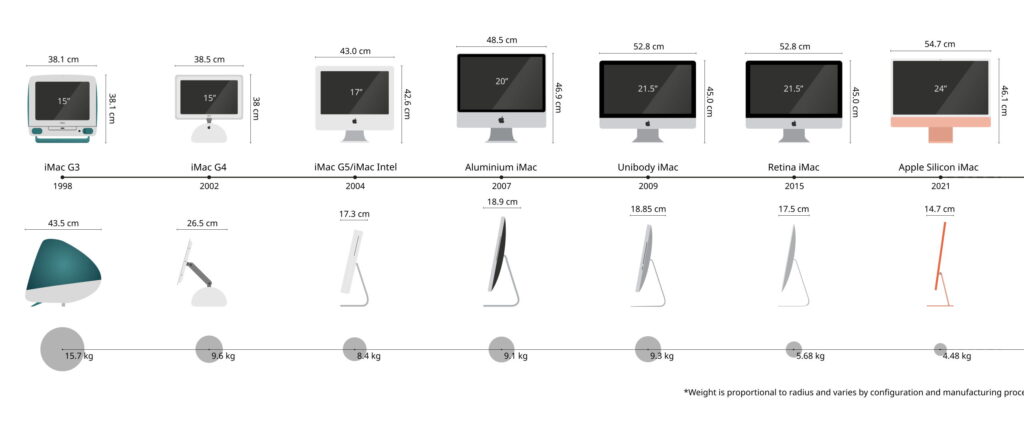A brief history of the all-in-one Mac

From the outset, the Macintosh was a single integrated unit, at a time when other personal computers came with separate displays.
Macintosh 128K (1984), Apple Museum Prague. Image by Benoît Prieur, via Wikimedia Commons.
It took three years for Macs to diverge into the all-in-one SE and the modular Macintosh II with its conventional case and separate colour monitor. The meteoric rise of desktop publishing demanded large, deep and heavy cathode-ray tube (CRT) colour displays that only came separately, and needed long graphics cards that had to be fitted inside the computer’s chassis.
Although the Mac SE weighed up to almost 10 kg (22 pounds), many lugged them around in soft cases slung over their shoulders, providing a degree of portability. There are some folk whose backs still bear witness to those days of the luggable Mac.
Integral CRT displays hardly changed over this period. The Macintosh 128K came with a 9 inch screen displaying a mere 512 x 342 pixels in monochrome. Ten years later, the Color Classic was the first all-in-one to come with a 10 inch colour screen, and that only increased resolution to 512 x 384 pixels. Neither was there any support for external displays, until the LC 520 in July 1993, with its 14 inch colour CRT at 640 x 480 resolution and display port.
During the 1990s, Apple offered various Power Macintosh, Performa and LC all-in-one models featuring integral or piggybacked displays, culminating in the Power Macintosh 5500 in 1997, with its 15 inch CRT of which less than 13 inches were viewable, and supporting up to 832 x 624 pixels.
Twentieth Anniversary Macintosh (1997). Image by Shelby Jueden, via Wikimedia Commons.
Apple’s next innovative all-in-one was the Twentieth Anniversary Macintosh (TAM), released a year late in 1997. It came with a 12.1 inch backlit active-matrix screen rather than the traditional CRT, in this unique design. Although a limited edition intended to be a collector’s item, it was overpriced and sold poorly, and has since been eclipsed by the most innovative model since the original 128K.
In May 1998, Apple announced the first iMac, based on a PowerPC G3 processor and a 15 inch CRT, of which 13.8 inches are viewable at resolutions of up to 1024 x 768 pixels. The design wrapped the case around the bulk of the display in the form of a ‘gumdrop’, using coloured translucent plastic later offered in a range of bright colours.
iMac G3 (1998). Image by Felix Winkelnkemper, via Wikimedia Commons.
It was also technically innovative, featuring novel USB ports and discarding the traditional floppy disk drive in favour of optical and hard drives. This shipped in August 1998, with hardware revisions that October and the following January.
A few months later Apple quietly slipped out the Power Macintosh G3 All-in-One, but that proved to be a dead-end and has been largely forgotten in favour of the iconic iMac.
By January 2002, flat-panel displays were starting to displace bulky CRTs, and Apple made use of them in its first flat-panel iMac. This featured a PowerPC G4 processor, and a 15 inch TFT active-matrix LCD delivering up to 1024 x 768 pixels. The computer components were assembled into a heavy hemispherical base on which the display was mounted using a hinged stainless steel arm resembling an Anglepoise desk lamp, which had been designed in 1932 by George Carwardine and is still in production.
iMac G4 (2002). Image by Maxime Bober, via Wikimedia Commons.
This ‘Anglepoise’ mount remains the best adjustable mechanism used with a display, ensured effortless positioning to suit each user, and eventually supported 20 inch flat-panel displays.
iMac G4 (2002), display mount. Image by Maxime Bober, via Wikimedia Commons.
With displays now thin enough to allow computer components to be integrated behind the screen, the next step was to eliminate the heavy base. Apple achieved that in August 2004 with the iMac G5, in its 17 and 20 inch models. With the switch to Intel processors and further integration in computer components, display size rose to 24 inches in 2007, and 27 inches two years later.
For many, the zenith of the iMac came in Retina 5K displays first offered in 2014, and the most powerful Intel iMac of all, the 27 inch iMac Pro released at the end of 2017. The latter features Intel Xeon processors with 8 or 10 cores together with the new T2 security chip. Although it doesn’t appear to have sold well, it was popular with developers and others during the hiatus between the Mac Pro models of 2013 and 2019.
Although the iMac Pro was the first Mac to feature a T2 chip, their inclusion in other iMacs was delayed until Apple had already announced its move to Apple silicon models. The last Intel iMac with a 27 inch Retina 5K display was released in August 2020, three months before Apple shipped the first M1 Mac mini and others.
Since May 2021, Apple has offered a succession of three iMacs powered by its M-series chips, all with a 24 inch Retina 4.5K display. They follow in the line of the original iMac from 1998, and come in a range of colours. But there are many who are still clinging onto ageing Intel iMacs in the hope that, one day, Apple will offer an all-in-one in the spirit of the iMac Pro, with a Pro grade chip and a 27 inch Retina 5K display.
Evolution of iMacs. Graphics by Giulia Piccoli Trapletti, via Wikimedia Commons.




